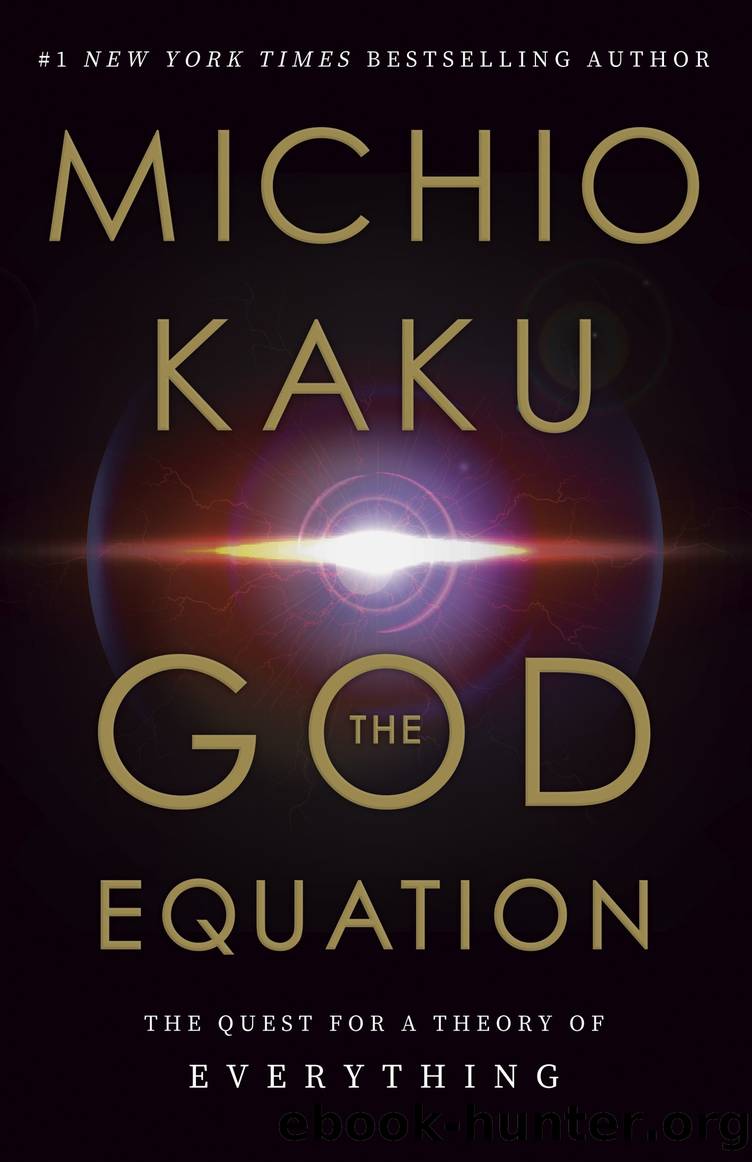The God Equation by Michio Kaku

Author:Michio Kaku [Kaku, Michio]
Language: eng
Format: epub
Publisher: Knopf Doubleday Publishing Group
Published: 2021-04-06T00:00:00+00:00
What Is a Black Hole?
The basic idea of a black hole actually can be traced back to Newtonâs discovery of the laws of gravity. His Principia gave us a simple picture: if you fire a cannonball with enough energy, it will completely circle the Earth, then return to its original point.
But what happens if you aim the cannonball straight up? Newton realized that the cannonball will eventually reach a maximum height and then fall back to Earth. But with enough energy, the cannonball would reach escape velocityâthat is, the speed necessary to escape the Earthâs gravity and soar into space, never to return.
It is a simple exercise, using Newtonâs laws to calculate the escape velocity of the Earth, which turns out to be 25,000 miles per hour. This is the velocity that our astronauts had to attain to reach the moon in 1969. If you do not reach escape velocity, then you will either enter orbit or fall back to Earth.
In 1783, an astronomer named John Michell asked himself a deceptively simple question: What happens if the escape velocity is the speed of light? If a light beam is emitted from a giant star so massive that its escape velocity is the speed of light, then perhaps even its light cannot escape. All light emitted from this star will eventually fall back into the star. Michell called these dark stars, celestial bodies that appeared black because light could not escape their immense gravity. Back in the 1700s, scientists knew little about the physics of stars and did not know the correct value for the speed of light, and hence this idea languished for several centuries.
In 1916, during World War I, German physicist Karl Schwarzschild was stationed on the Russian front as an artilleryman. While fighting in the middle of a bloody war, he found time to read and digest Einsteinâs famous 1915 paper introducing general relativity. In a brilliant stroke of mathematical insight, Schwarzschild somehow found an exact solution of Einsteinâs equations. Instead of solving the equations for a galaxy or the universe, which was too difficult, he started with the simplest of all possible objects, a tiny point particle. This object, in turn, would approximate the gravity field of a spherical star as seen from a distance. One could then compare Einsteinâs theory with experiment.
Einsteinâs reaction to Schwarzschildâs paper was ecstatic. Einstein realized that this solution of his equations would allow him to make more precise calculations with his theory, such as the bending of starlight around the sun and the wobbling of the planet Mercury. So instead of making crude approximations to his equations, he could calculate exact results from his theory. This was a monumental breakthrough that would prove important for understanding black holes. (Schwarzschild died shortly after his remarkable discovery. Saddened, Einstein wrote a moving eulogy for him.)
But despite the enormous impact of Schwarzschildâs solution, it also raised some bewildering questions. From the start, his solution had weird properties that pushed the boundaries of our understanding of space and time.
Download
This site does not store any files on its server. We only index and link to content provided by other sites. Please contact the content providers to delete copyright contents if any and email us, we'll remove relevant links or contents immediately.
The Complete Stick Figure Physics Tutorials by Allen Sarah(6638)
Secrets of Antigravity Propulsion: Tesla, UFOs, and Classified Aerospace Technology by Ph.D. Paul A. Laviolette(3450)
Thing Explainer by Randall Munroe(3327)
The River of Consciousness by Oliver Sacks(2992)
The Order of Time by Carlo Rovelli(2714)
I Live in the Future & Here's How It Works by Nick Bilton(2524)
How To by Randall Munroe(2475)
A Brief History of Time by Stephen Hawking(2473)
The Great Unknown by Marcus du Sautoy(2186)
What If?: Serious Scientific Answers to Absurd Hypothetical Questions by Randall Munroe(2170)
Blockchain: Ultimate Step By Step Guide To Understanding Blockchain Technology, Bitcoin Creation, and the future of Money (Novice to Expert) by Keizer Söze(2137)
Midnight in Chernobyl by Adam Higginbotham(2078)
Networks: An Introduction by Newman Mark(1998)
The Meaning of it All by Richard Feynman(1909)
Easy Electronics by Charles Platt(1864)
The Tao of Physics by Fritjof Capra(1849)
When by Daniel H Pink(1777)
Midnight in Chernobyl: The Untold Story of the World's Greatest Nuclear Disaster by Adam Higginbotham(1775)
Introducing Relativity by Bruce Bassett(1754)
